A Characterization and Cell Toxicity Assessment of Particulate Pollutants from Road Traffic Sites in Kano State, Nigeria
Abstract
1. Introduction
2. Materials and Method
2.1. Background of Study
2.2. Air Sampling
2.3. Scanning Electron Microscopy and Energy Dispersive X-ray Analysis
2.4. Particle Extraction for Cytotoxicity Studies
2.4.1. Cell Culture
2.4.2. 3-(4,5-Dimethythiazol-2-yl)-2,5-Diphenyltetrazolium Bromide Testing
2.4.3. Cell Fixation and Staining using 4′, 6-Diamino-2-Phenylindole
2.4.4. Fluorescence Microscopy
3. Results
3.1. Scanning Electron Microscopy and EDX Results
3.2. The Result of the Cytotoxicity Assessment by the MTT Assay
3.3. Results of Cellular Viability using DAPI Staining
4. Discussion
5. Conclusions
Author Contributions
Funding
Institutional Review Board Statement
Informed Consent Statement
Data Availability Statement
Acknowledgments
Conflicts of Interest
Appendix A
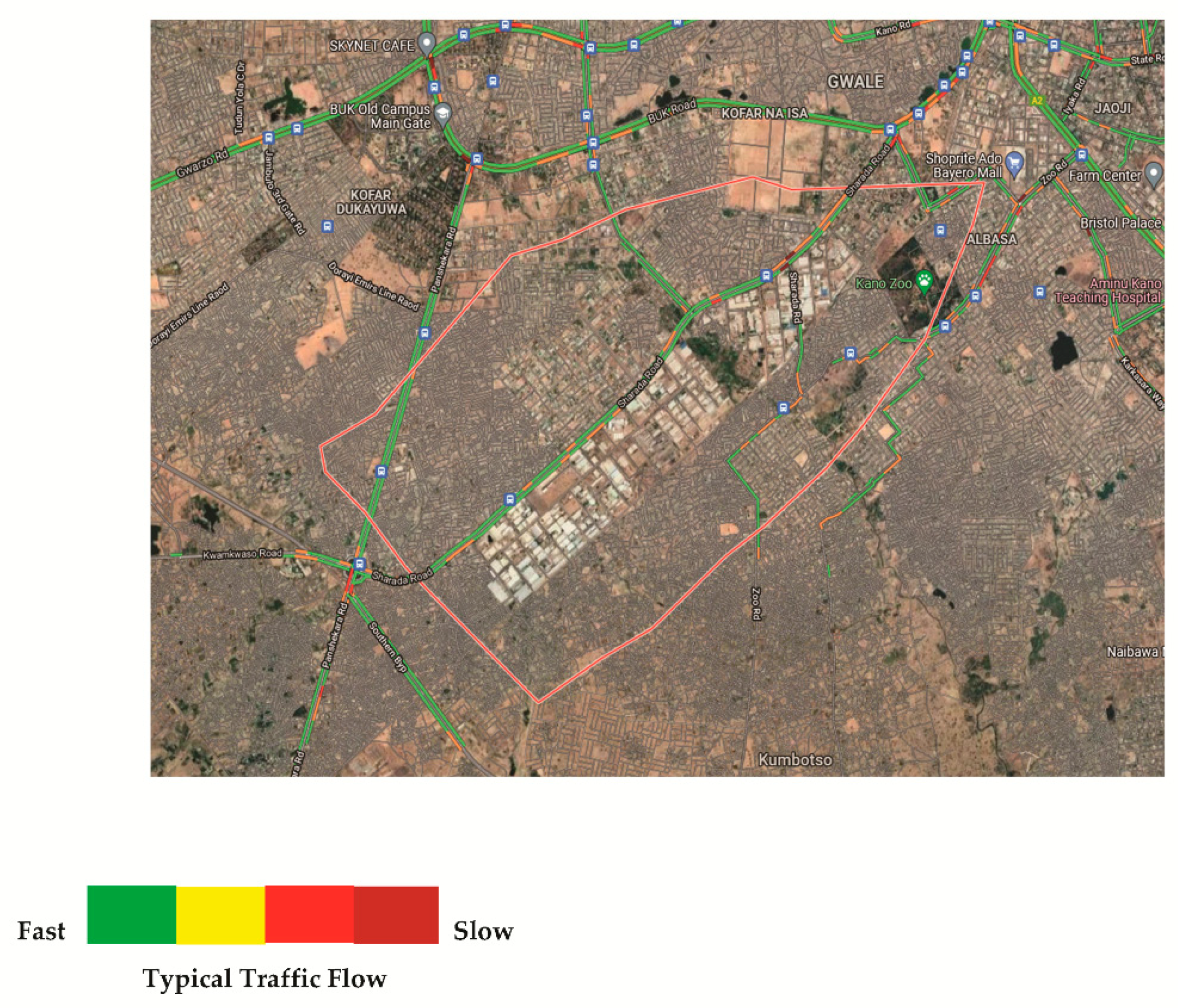

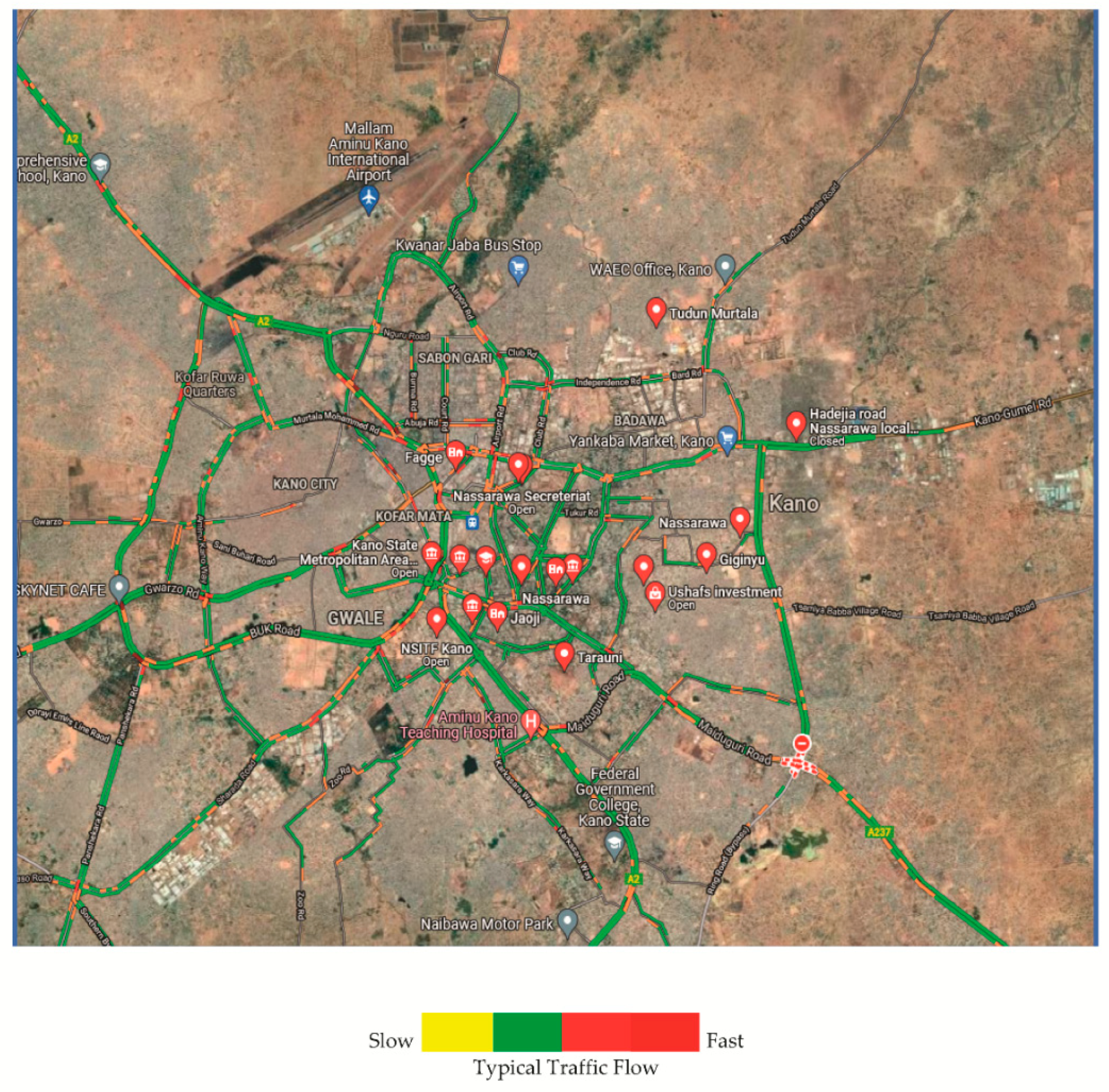
References
- Kim, B.M.; Park, J.-S.; Kim, S.W.; Kim, H.; Jeon, H.; Cho, C.; Kim, J.-H.; Hong, S.; Rupakheti, M.; Panday, A.K.; et al. Source apportionment of PM10 mass and particulate carbon in the Kathmandu Valley, Nepal. Atmos. Environ. 2015, 123, 190–199. [Google Scholar] [CrossRef]
- Squizzato, S.; Cazzaro, M.; Innocente, E.; Visin, F.; Hopke, P.K.; Rampazzo, G. Urban air quality in a mid-size city—PM2.5 composition, sources and identification of impact areas: From local to long range contributions. Atmos. Res. 2017, 186, 51–62. [Google Scholar] [CrossRef]
- Men, C.; Liu, R.; Wang, Q.; Guo, L.; Miao, Y.; Shen, Z. Uncertainty analysis in source apportionment of heavy metals in road dust on positive matrix factorization model and geographic information system. Sci. Total Environ. 2019, 652, 27–39. [Google Scholar] [CrossRef] [PubMed]
- Touzi, B.; Mabrouki, C.; Farchi, A. Sustainable Road Transportation in developed and developing countries: Framework and Future research. Int. J. Eng. Res. Technol. 2015, 4. Available online: https://www.researchgate.net/publication/323019562_Sustainable_Road_Transport_in_Developed_and_Developing_Countries_Framework_and_Future_Research (accessed on 21 February 2021).
- Schipper, L.; Fabian, H.; Leather, J. Transport and Carbon Dioxide Emissions: Forecasts, Options Analysis and Evaluation; ADB Sustainable Development Working Paper Series; ADB: Mandaluyong, Philipines, 2009. [Google Scholar]
- Gwilliam, K.M.; Bofinger, H. Africa’s Transport Infrastructure: Mainstreaming Maintenance and Management; World Bank Publications: Washington, DC, USA, 2011. [Google Scholar]
- Pirrone, N.; Cinerella, S.; Feng, X.; Finkelman, B.R.; Friedli, R.H.; Leaner, J.; Mason, R.; Mukherjee, A.B.; Stratcher, B.G.; Streets, G.D.; et al. Global mercury emissions into the atmosphere from anthropegenic and natural sources. Atmos. Chem. Phys. 2010, 10, 5951–5964. [Google Scholar] [CrossRef]
- Emmanuel, A.O. The impact of road development and expansion on urban cities “A case study of Akure metropolis”. Worldw. J. Multidiscip. Res. Dev. 2015, 2, 46–48. [Google Scholar]
- Jayasinghe, A.; Sano, K.; Nishiuchi, H. Network Centrality Assessment (NCA) as an alternative approach to predict vehicular traffic volume: A case of Colombo, Sri Lanka. Adv. Transp. Stud. 2015, 11, 834–853. [Google Scholar]
- Ishii, S.; Bell, J.N.B.; Marshall, F.M. Phytotoxic risk assessment of ambient air pollution on agricultural crops in Selangor State, Malaysia. Environ. Pollut. 2007, 150, 267–279. [Google Scholar] [CrossRef] [PubMed]
- Vlachokhostas, C.; Nastis, S.A.; Achillas, C.; Kalogeropoulos, K.; Karmiris, I.; Moussiopoulos, N.; Chourdakis, E.; Banias, G.; Limperi, N. Economic damages of Ozone air pollution to crops using combined air quality and GIS modeling. Atmos. Environ. 2010, 44, 3352–3361. [Google Scholar] [CrossRef]
- Koupal, J.; Palacios, C. Impact of new fuel specifications on vehicle emissions in Mexico. Atmos. Environ. 2019, 201, 41–49. [Google Scholar] [CrossRef]
- Shi, S.; Zhang, H.; Yang, W.; Zhang, Q.; Wang, X. A life cycle assessment of battery electric and internal combustion engine vehicles: A case in Hebei province China. J. Clean. Prod. 2019, 228, 606–618. [Google Scholar] [CrossRef]
- Kingombe, C. Africa’s Rising Middle Class Amid Plenty and Extreme Poverty; European Centre for Development Policy Management (ECDPM): Maastricht, The Netherlands, 2014. [Google Scholar] [CrossRef]
- Davila, A.F.; Rey, D.; Mohammed, K.; Rubio, B.; Guerra, A.P. Mapping the sources of urban dust in a coastal environment by measuring magnetic parameters of Platanus hispanica leaves. Environ. Sci. Technol. 2006, 40, 3922–3928. [Google Scholar] [CrossRef] [PubMed]
- Adeyanju, A.A.; Manohar, K. Effect of Vehicular Emission on Environmental pollution in Lagos. Sci-Afric J. Sci. Issues Res. Essays 2017, 5, 34–51. [Google Scholar]
- Hamidi, M.; Kavianpour, M.R.; Shao, Y. Synoptic analysis of dust storms in the Middle East. Asia-Pac. J. Atmos. Sci. 2013, 49, 279–286. [Google Scholar] [CrossRef]
- Middleton, N.; Kang, U. Sand and dust storms: Impact mitigation. Sustainability 2017, 9, 1053. [Google Scholar] [CrossRef]
- Klose, M.; Shao, Y.; Karremann, K.M.; Fink, H.A. Sahel dust zone and synoptic background. Geophys. Res. Lett. 2010, 37. [Google Scholar] [CrossRef]
- Lyngsie, G.; Awadzi, T.W.; Breuning-Madsen, H. Origin of Harmattan dust settled in Northern Ghana—Long transported or local dust? Geoderma 2010, 167, 351–359. [Google Scholar] [CrossRef]
- Riedl, M.; Diaz-Sanchez, D. Biology of diesel exhaust effects on respiratory function. J. Allergy Clin. Immunol. 2005, 115, 221–228. [Google Scholar] [CrossRef]
- Gonzalez-Diaz, S.N.; Arias-Cruz, A.; Macouzet-Sanchez, C.; Partida-Ortega, B.A. Impact of air pollution in respiratory allergic diseases. Med. Univ. 2016, 18, 212–215. [Google Scholar] [CrossRef]
- United States Environmental Protection Agency. Exposure and Human Health Reassessment of 2, 3, 7, 8-Tetrachlorodibenzo-p-Dioxin (TCDD) and Related Compounds National Academy Sciences External Review Draft; United States Environmental Protection Agency: Washington, DC, USA, 2004. Available online: https://www.cfpub.epa.gov (accessed on 9 May 2021).
- Elminir, H.K. Dependence of urban air pollutants on meteorology. Sci. Total Environ. 2005, 350, 225–237. [Google Scholar] [CrossRef]
- Dominici, F.; McDermott, A.; Zeger, S.L.; Samet, J.M. National maps of the effects of particulate matter on mortality: Exploring geographical variation. Environ. Health Perspect. 2003, 111, 39–44. [Google Scholar] [CrossRef] [PubMed]
- Langner, M.; Endlicher, W. Shrinking Cities: Effects on Urban Ecology and Challenges for Urban Development; Peter Lang GmbH: Berlin, Germany, 2007; pp. 17–35. [Google Scholar]
- Tecer, L.H.; Alagha, O.; Karaca, F.; Tuncel, G.; Eldes, N. Particulate matter (PM 2.5, PM10-2.5, and PM 10) and children’s hospital admissions for asthma and respiratory diseases: A bidirectional case-crossover study. J. Toxicol. Environ. Health Part A 2008, 71, 512–520. [Google Scholar] [CrossRef] [PubMed]
- World Health Organization (WHO). Household Air Pollution and Health. Updated 2018. Available online: https://www.who.int/newsroom/fact-sheets/detail/household-air-pollution-and-health (accessed on 7 July 2021). Updated 2018.
- Lagorio, S.; Forastiere, F.; Pistelli, R.; Lavorone, I.; Michelozzi, P.; Fano, V.; Marconi, A.; Ziemacki, G.; Ostro, D.B. Air pollution and lung function among susceptible adult subjects: A panel study. Environ. Health 2006, 5, 11. [Google Scholar] [CrossRef] [PubMed]
- Zeka, A.; Zanobetti, A.; Schwartz, J. Individual-level modifiers of the effects of particulate matter on daily mortality. Am. J. Epidemiol. 2006, 163, 849–859. [Google Scholar] [CrossRef] [PubMed]
- Barnett, A.G.; Williams, G.M.; Schwartz, J.; Neller, A.H.; Best, T.L.; Petroeschevsky, A.L.; Simpson, R.W. Air pollution and child respiratory health: A case crossover study in Australia and New Zealand. Am. J. Respir. Crit. Care Med. 2005, 171, 1272–1278. [Google Scholar] [CrossRef] [PubMed]
- Ostro, B.; Feng, W.Y.; Broadwin, R.; Lipsett, M. The effects of components of fine particulate air pollution on mortality in California: Results from CALFINE. Environ. Health Perspect. 2007, 115, 13–19. [Google Scholar] [CrossRef]
- Saenz, J.L.; Wong, R.; Ailshire, J.A. Indoor air pollution and cognitive function among older Mexican adults. J. Epidemiol. Commun. Health 2018, 72, 21–26. [Google Scholar] [CrossRef]
- Thompson, L.M. Household Air Pollution from Cooking Fires Is a Global Problem. Am. J. Nurs. 2019, 119, 61–64. [Google Scholar] [CrossRef]
- Kim, E.; Park, H.; Park, E.A.; Hong, Y.C.; Ha, M.; Kim, H.C.; Ha, E.H. Particulate matter and early childhood body weight. Environ. Int. 2016, 94, 591–599. [Google Scholar] [CrossRef]
- Roy, A.; Hu, W.; Wei, F.; Korn, L.; Chapman, R.S.; Zhang, J.J. Ambient particulate matter and lung function growth in Chinese children. Epidemiology 2012, 23, 464–472. [Google Scholar] [CrossRef]
- Franchini, M.; Mannucci, P.M. Thrombogenicity and cardiovascular effects of ambient air pollution. Blood 2011, 118, 2405–2412. [Google Scholar] [CrossRef] [PubMed]
- Nemmar, A.; Hoet, P.H.; Dinsdale, D.; Vermylen, J.; Hoylaerts, M.F.; Nemery, B. Diesel exhaust particles in lung acutely enhance experimental peripheral thrombosis. Circulation 2003, 107, 1202–1208. [Google Scholar] [CrossRef] [PubMed]
- Hamed, S.A.; Hamed, E.A.; Zakary, M.M. Oxidative stress and S-100B protein in children with bacterial meningitis. BMC Neurol. 2009, 9, 51. [Google Scholar] [CrossRef] [PubMed]
- Maher, P.; Schubert, D. Signaling by reactive oxygen species in the nervous system. Cell Mol. Life Sci. 2000, 57, 1287–1305. [Google Scholar] [CrossRef]
- Hvidtfeldt, U.A.; Sorensen, M.; Geels, C.; Ketzel, M.; Khan, J.; Tjonneland, A.; Overvad, K.; Brandt, J.; Raaschou-Nielsen, O. Long-term residential exposure to PM2.5, PM10, black carbon, NO2, and ozone and mortality in a Danish cohort. Environ. Int. 2019, 123, 265–272. [Google Scholar] [CrossRef]
- Ansari, M.; Ehrampoush, M.H. Meteorological correlates and AirQ+ health risk assessment of ambient fine particulate matter in Tehran, Iran. Environ. Res. 2019, 170, 141–150. [Google Scholar] [CrossRef]
- Liu, F.; Chen, G.; Huo, W.; Wang, C.; Liu, S.; Li, N.; Mao, S.; Hou, Y.; Lu, Y.; Xiang, H. Associations between long-term exposure to ambient air pollution and risk of type 2 diabetes mellitus: A systematic review and meta-analysis. Environ. Pollut. 2019, 252, 1235–1245. [Google Scholar] [CrossRef]
- Luo, G.W.; Zhang, L.Y.; Hu, X.S.; Qiu, R.Z. Quantifying public health benefits of PM2.5 reduction and spatial distribution analysis in China. Sci. Total Environ. 2020, 719, 137445. [Google Scholar] [CrossRef]
- Wang, J.Z.; Zhang, L.F.; Niu, X.S.; Liu, Z.K. Effects of PM2.5 on health and economic loss: Evidence from Beijing-Tianjin-Hebei region of China. J. Clean. Prod. 2020, 257, 120605. [Google Scholar] [CrossRef]
- Schwarze, P.; Totlandsal, A.; Herseth, I.J.; Holme, A.J.; Lag, M.; Refsnes, M.; Overik, J.; Sandberg, W.; Bolling, K.A. Importance of sources and components of particulate air pollution for cardio-pulmonary inflammatory responses. In Air Pollution; Rijeka, V.V., Ed.; Sciyo: Oslo, Norway, 2010; pp. 47–54. [Google Scholar] [CrossRef]
- Tiotiu, A.I.; Novakova, P.; Nedeva, D.; Chong-Neto, H.J.; Novakova, S.; Steiropoulos, P.; Kowal, K. Impact of Air Pollution on Asthma Outcomes. Int. J. Environ. Res. Public Health 2020, 17, 6212. [Google Scholar] [CrossRef]
- Bhatia, V.; Elnagary, L.; Dakshinamurti, S. Tracing the Path of Inhaled Nitric Oxide: Biological Consequences of Protein Nitrosylation. Pediatric Pulmonol. 2021, 56, 525–538. [Google Scholar] [CrossRef] [PubMed]
- Rouadi, P.W.; Idriss, S.A.; Naclerio, R.M.; Peden, D.B.; Ansotegui, I.J.; Canonica, G.W.; Gonzalez-Diaz, S.N.; Rosario Filho, N.A.; Ivancevich, J.C.; Hellings, P.W.; et al. Immunopathological Features of Air Pollution and Its Impact on Inflammatory Airway Diseases (IAD). World Allergy Organ. J. 2020, 13, 100467. [Google Scholar] [CrossRef] [PubMed]
- Sowlat, M.H.; Gharibi, H.; Yunesian, M.; Mahmoudi, M.T.; Lotfi, S. A novel, Fuzzy-based air quality index (FAQI) for air quality assessment. Atmos. Environ. 2011, 45, 2050–2059. [Google Scholar] [CrossRef]
- US Environment Protection Agency (EPA). Guideline for Developing an Ozone Forecasting Program; EPA-454/R-99-009; US EPA: Washington, DC, USA, 1999. [Google Scholar]
- Nordling, E.; Berglind, N.; Mele, E.; Emenius, G.; Hallberg, J.; Nyberg, F.; Pershagen, G.; Svartengren, M.; Wickman, M.; Bellander, T. Traffic-Related Air Pollution and Childhood Respiratory Symptoms, Function and Allergies. Epidemiology 2008, 19, 401–408. [Google Scholar] [CrossRef] [PubMed]
- Phalen, F.O.R. The particulate air pollution controversy. Dordrecht, Netherlands. Int. J. Epidemiol. 2003, 32, 128. [Google Scholar]
- Barnett, A.G.; Williams, G.M.; Schwartz, J.; Best, T.L.; Neller, A.H.; Petroeschevsky, A.L.; Simpson, R.W. The effects of air pollution on hospitalizations for cardiovascular disease in elderly people in Australian and New Zealand cities. Environ. Health Perspect. 2006, 114, 1018–1023. [Google Scholar] [CrossRef]
- Crouse, D.L.; Peters, P.A.; Van Donkelaar, A.; Goldberg, M.S.; Villeneuve, P.J.; Brion, O.; Khan, S.; Atari, D.O.; Jerrett, M.; Pope, C.A.; et al. Risk of non-accidental and cardiovascular mortality in relation to long term exposure to low concentrations of fine particle matter: A Canadian-national level cohort study. Environ. Health Perspect. 2012, 120, 708–714. [Google Scholar] [CrossRef]
- Ma, Y.; Zhang, M.; Jin, S.; Gong, W.; Chen, N.; Chen, Z.; Jin, Y.; Shi, Y. Long-term investigation of Aerosol optical and Radiative Characteristics in a Typical Megacity of Central China During Winter Haze Periods. J. Geophys. Res. 2019, 124, 12093–12106. [Google Scholar] [CrossRef]
- Sadiq, A.A.; Khardi, S.; Trunfio-Sfarghiu, A.; Alao, A.M.; Salam, P.S.; Faruk, A. Emissions from road transport vehicles and respiratory health in rural and urban communities, Kano state, Nigeria: A comparative cross sectional study (Full paper). In Proceedings of the International Conference for Environmental Health and Biotechnology (ICESB 2021), Osaka, Japan, 16–18 December 2021. [Google Scholar]
- Schipper, O.N.; Haddad, S.L.; Fullam, S.; Pourzal, R.; Wimmer, M.A. Wear Characteristics of Conventional Ultrahigh-Molecular-Weight Polyethylene versus Highly Cross-Linked Polyethylene in Total Ankle Arthroplasty. Foot Ankle Int. 2018, 39, 1335–1344. [Google Scholar] [CrossRef]
- Mossman, T. Rapid colorimetric assay for cellular growth and survival: Application to proliferation and cytotoxicity assays. J. Immunol. Methods 1983, 65, 55–63. [Google Scholar] [CrossRef]
- Kepp, O.; Galluzzi, L.; Lipinski, M.; Yuan, J.; Kroemer, G. Cell death assays for drug discovery. Nat. Rev. Drug Discov. 2011, 10, 221–237. [Google Scholar] [CrossRef] [PubMed]
- Marmureanu, L.; Marin, C.; Andrei, S.; Antonescu, B.; Ene, D.; Boldeanu, M.; Vasilescu, J.; Vitelaru, C.; Cadar, O.; Levei, E.-A. Orange Snow—A Saharan Dust Intrusion over Romania during Winter Conditions. Remote Sens. 2019, 11, 2466. [Google Scholar] [CrossRef]
- Naidja, L.; Ali-Khodja, H.; Khardi, S. Sources and levels of particulate matter in North African and Sub-Saharan cities: A literature review. Environ. Sci. Pollut. Res. 2018, 25, 12303–12328. [Google Scholar] [CrossRef] [PubMed]
- Key, M.R.; Johnson, C.C.; Horstwood, A.S.M.; Lapworth, J.D.; Knights, K.; Kemp, J.S.; Watts, J.M.; Gillespie, M.; Adekanmi, M. Investigating high Zircon concentration in the fine fraction of stream sediment draining the Pan-African Dahomeyan Terrane in Nigeria. Appl. Geochem. 2017, 27, 1525–1539. [Google Scholar] [CrossRef]
- Ma, Y.; Martynkova, S.G.; Valaskova, M.; Matejka, V.; Lu, Y. Effects of ZrSi04 in non-metallic brake friction materials on friction performance. Tribol. Int. 2012, 41, 166–174. [Google Scholar] [CrossRef]
- Air Quality: Health and Environment Alliance (HEAL). Updated 2018. Available online: https://www.env-health.org/issues/air-quality (accessed on 18 June 2021).
- Tan, Z. Air Pollution and Greenhouse Gases: From Basic Concepts to Engineering Applications for Air Emission Control; Springer Science + Business Media: Singapore, 2014; ISBN 978-981-287-212-8. [Google Scholar] [CrossRef]
- Annesi-Maesano, I.; Forastiere, F.; Balmes, J.; Garcia, E.; Harkema, J.; Holgate, S.; Kelly, F.; Khreis, H.; Hoffmann, B.; Maesano, C.N.; et al. The clear and persistent impact of air pollution on chronic respiratory diseases: A call for interventions. Eur. Respir. J. 2012, 18, 2002981. [Google Scholar] [CrossRef]
- Hitchins, J.; Morowska, L.; Wolff, R.C.; Dale, G. Concentrations of sub micrometer particles from vehicle emissions near a major road. Atmos. Environ. 2000, 34, 51–59. [Google Scholar] [CrossRef]
- Tittia, P.; Raunemaa, P.; Tissari, J.; Yli-Tuomi, T.; Leskinen, A.; Kukkonen, J.; Harkonen, J.; Karpinnen, A. Measurements and modeling of PM 2.5 concentrations near a major road in Kuopio, Finland. Atmos. Environ. 2000, 36, 4057–4068. [Google Scholar] [CrossRef]
- Hughes, L.S.; Cass, G.R.; Gone, J.; Ames, M.; Olmez, I. Physical and chemical characterization of atmospheric ultrafine particles in the Los Angeles area. Environ. Sci. Technol. 1998, 32, 1153–1161. [Google Scholar] [CrossRef]
- Harrison, R.M.; Shi, J.P.; Xi, S.; Khan, A.; Mark, D.; Kinnersley, R.; Yin, J. Measurement of number, mass and size distribution of particles in the atmosphere. Philos. Trans. R. Soc. Lond. Ser. A Math. Phys. Eng. Sci. 2000, 358, 2567–2580. [Google Scholar] [CrossRef]
- Vega, E.; Ruiz, H.; Escalona, S.; Cervantes, A.; Lopez–Veneroni, D.; Gonzalez–Avalos, E.; Sanchez–Reyna, G. Chemical composition of fine particles in Mexico City during 2003–2004. Atmos. Pollut. Res. 2011, 2, 477–483. [Google Scholar] [CrossRef]
- Mues, A.; Manders, A.; Schaap, M.; Van Ulft, L.; Van Meijgaard, E.; Builtjes, P.J.H. Differences in particulate matter concentrations between urban and rural regions under current and changing climate conditions. Atmos. Environ. 2013, 80, 232–247. [Google Scholar] [CrossRef]
- Langner, M.; Kull, M.; Endlicher, W.R. Determination of PM10 deposition based on antimony flux to selected urban surfaces. Environ. Pollut. 2011, 159, 2028–2034. [Google Scholar] [CrossRef] [PubMed]
- Akinlade, G.O.; Olaniyi, H.B.; Olise, F.S.; Owoade, O.K.; Almeida, S.M.; Almeida-Silva, M.; Hopke, P.K. Spatial and temporal variations of the particulate size distribution and chemical composition over Ibadan, Nigeria. Environ. Monit. Assess. 2015, 187, 544. [Google Scholar] [CrossRef]
- Zircon Occurrence in Nigeria, Ministry of Mines and Steel development Federal Republic of Nigeria. Updated January 2021. Available online: https://portal.minesandsteel.gov.ng/MarketPlace/Mineral/Occurrence/141 (accessed on 10 May 2021).
- Efe, S.I. Spatial distribution of particulate air pollution in Nigerian cities: Implications for human health. J. Environ. Health Res. 2008, 7, 107–116. [Google Scholar]
- Ana, G.; Odeshi, T.; Sridhar, M.K.; Ige, M.O. Outdoor respirable particulate matter and the lung function status of residents of selected communities in Ibadan, Nigeria. Perspect. Public Health 2014, 134, 169–175. [Google Scholar] [CrossRef]
- Geng, H.; Kang, S.; Jung, H.-J.; Choël, M.; Kim, H.; Ro, C.-U. Characterization of individual sub-micrometer aerosol particles collected in Incheon, Korea, by quantitative transmission electron microscopy energy dispersive X-ray spectrometry. J. Geophys. Res. 2010, 115, 15306. [Google Scholar] [CrossRef]
- Shikuan, J.; Yingying, M.; Ming, Z.; Wei, G.; Lianfa, L.; Xin, M. Comparation of Aerosol optical properties and Associated Radiative effects of Air pollution events between summer and winter: A case study in January and July 2014 over Wuhan, Central China. Atmos. Environ. 2019, 218, 117004. [Google Scholar] [CrossRef]
- Hu, Y.; Lin, J.; Zhang, S.; Kong, L.; Fu, H.; Chen, J. Identification of the typical metal particles among haze, fog, and clear episodes in the Beijing atmosphere. Sci. Total Environ. 2014, 1, 369–380. [Google Scholar] [CrossRef]
- Carslaw, K.; Boucher, O.; Spracklen, D.; Mann, G.; Rae, J.; Woodward, S.; Kulmala, M. A review of natural aerosol interactions and feedbacks within the earth system. Atmos. Chem. Phys. 2010, 10, 1701–1737. [Google Scholar] [CrossRef]
- Furusjo, E.; Sternbeck, J.; Cousins, A.P. PM (10) source characterization at urban and highway roadside locations. Sci. Total Environ. 2007, 387, 206–219. [Google Scholar] [CrossRef] [PubMed]
- Weckwerth, G. Verification of traffic emitted aerosol components in the ambient air of Cologne (Germany). Atmos. Environ. 2001, 35, 5525–5536. [Google Scholar] [CrossRef]
- Marcazzan, G.M.; Ceriani, M.; Valli, G.; Vecchi, R. Source apportionment of PM10 and PM2.5 in Milan (Italy) using receptor modelling. Sci. Total Environ. 2003, 317, 137–147. [Google Scholar] [CrossRef]
- Adachi, K.; Tainosho, Y. Characterization of heavy metal particles embedded in tire dust. Environ. Int. 2004, 30, 1009–1017. [Google Scholar] [CrossRef]
- Aguzzi, A.; O’connor, T. Protein aggregation diseases: Pathogenicity and therapeutic perspectives. Nat. Rev. Drug Discov. 2010, 9, 237–248. [Google Scholar] [CrossRef]
- Glabe, C.G. Structural classification of toxic amyloid oligomers. J. Biol. Chem. 2008, 283, 29639–29643. [Google Scholar] [CrossRef]
- Martins, I.C.; Kuperstein, I.; Rousseau, F. Lipids revert inert Ab amyloid fibrils to neurotoxic protofibrils that affect learning in mice. EMBO J. 2008, 27, 224–233. [Google Scholar] [CrossRef]
- Xue, W.-F.; Hellewell, A.L.; Radford, S.E. Fibril fragmentation enhances amyloid cytotoxicity. J. Biol. Chem. 2009, 284, 34272–34282. [Google Scholar] [CrossRef]
- Knowles, T.P.; Fitzpatrick, A.W.; Welland, M.E. Role of intermolecular forces in defining material properties of protein nanofibrils. Science 2007, 318, 1900–1903. [Google Scholar] [CrossRef]
- Lai, C.-H.; Lin, C.-H.; Liao, C.-C. Respiratory deposition and health risk of inhalation of particle-bound heavy metals in the carbon black feeding area of a tire manufacturer. Air Qual. Atmos. Health 2017, 10, 1281–1289. [Google Scholar] [CrossRef]
- Health Effects of Occupational Exposure to Respirable Crystalline Silica. DHHS (NIOSH) CDC Publication Number 2002-129; April 2002. Available online: https://www.cdc.gov/niosh/docs/2002-129/default.html (accessed on 17 June 2021).
- Elias, Z.; Poirot, O.; Daniere, C.M.; Terzetti, F.; Marande, M.A.; Dzwigaj, S.; Pezerat, H.; Fenoglio, I.; Fubini, B. Cytotoxic and transforming effects of silica particles with different surface properties in Syrian hamster embryo (SHE) cells. Toxicol. Vitr. 2000, 14, 409–422. [Google Scholar] [CrossRef]
- Atalay, H.; Celik, A.; Ayaz, F. Investigation of genotoxic and apoptotic effects of zirconium oxide nanoparticles (20nm) on L929 mouse fibroblast cell line. Chem. Biol. Interact. 2018, 296, 98–104. [Google Scholar] [CrossRef] [PubMed]
- Cossellu, G.; Motta, V.; Dioni, L.; Angelici, L.; Vigna, L.; Farronato, G.; Pesatori, A.; Bollati, V. Titanium and zirconium levels associated with changes in microRNAs expression: Results from a Human Cross-sectional Study on Obese Population. PLoS ONE 2016, 11, e016191. [Google Scholar] [CrossRef]
- Dominici, F.; Schwartz, J.; Di, Q.; Braun, D.; Choirat, C.; Zanobetti, A. Assessing adverse health effects of long-term exposure to low levels of ambient air pollution: Phase 1. Res. Rep. Health Eff. Inst. 2019, 200, 1–51. [Google Scholar]
- Brauer, M.; Brook, J.R.; Christidis, T.; Chu, Y.; Crouse, D.L.; Erickson, A.; Hystad, P.; Li, C.; Martin, R.V.; Meng, J.; et al. Mortality-air pollution associations in low-exposure environments (MAPLE): Phase 1. Res. Rep. Health Eff. Inst. 2019, 203, 1–87. [Google Scholar]
- Kohoutek, S.; Weinbruch, S.; Boltze, M. Reduction potential of environment responsive traffic control on roadside particulate matter and nitrogen oxide concentrations. Transp. Res. Rec. J. Transp. Res. Board. 2012, 2270, 162–170. [Google Scholar] [CrossRef]
- Gehrig, R.; Hill, M.; Buchmann, B.; Imhof, D.; Weingartner, E.; Baltensperger, U. Separate determination of PM10 emission factors of road traffic for tailpipe emissions and emissions from abrasion and resuspension processes. Int. J. Environ. Pollut. 2004, 22, 312–325. [Google Scholar] [CrossRef]
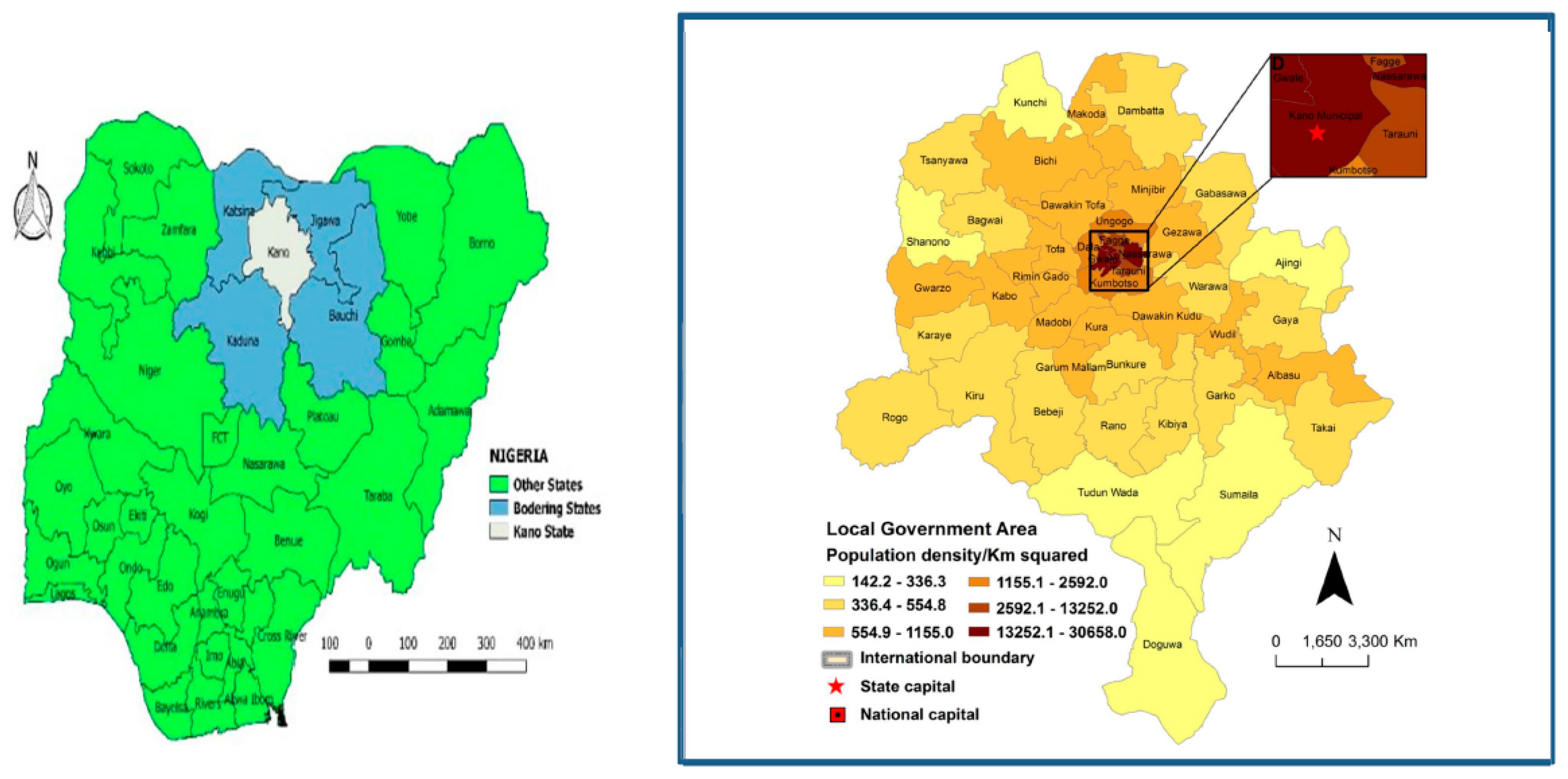
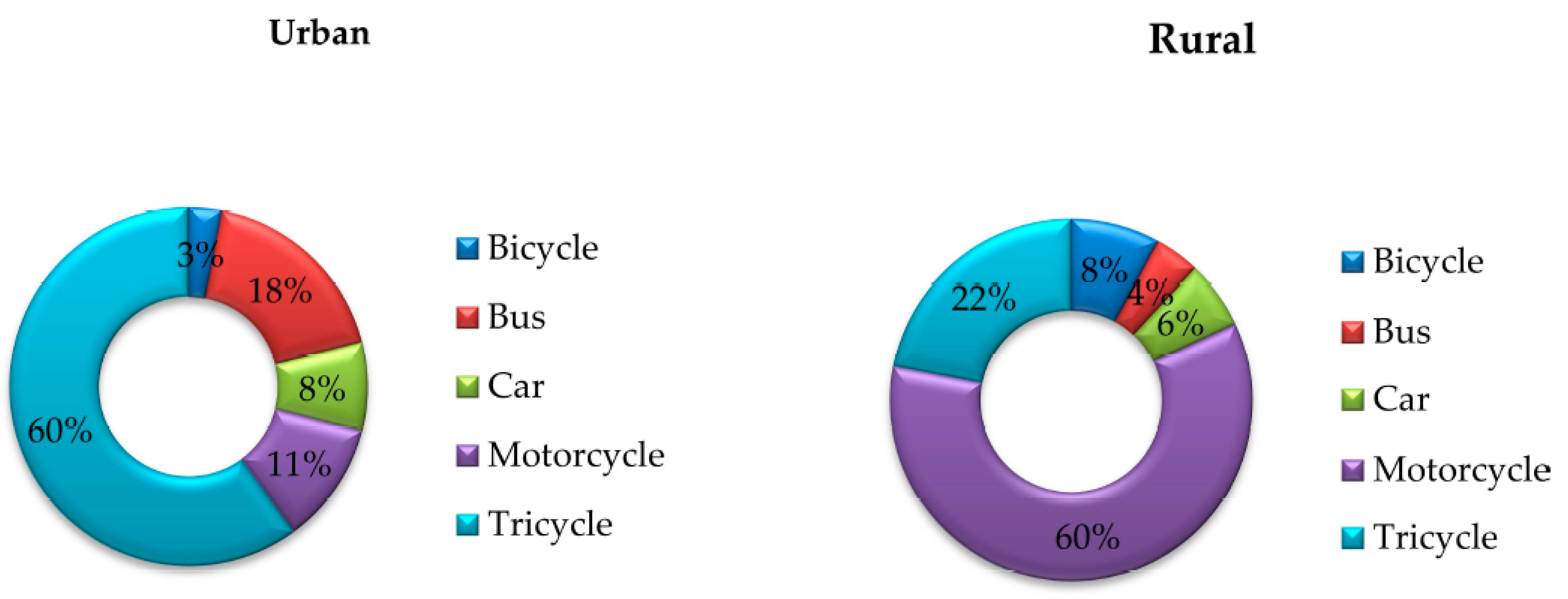
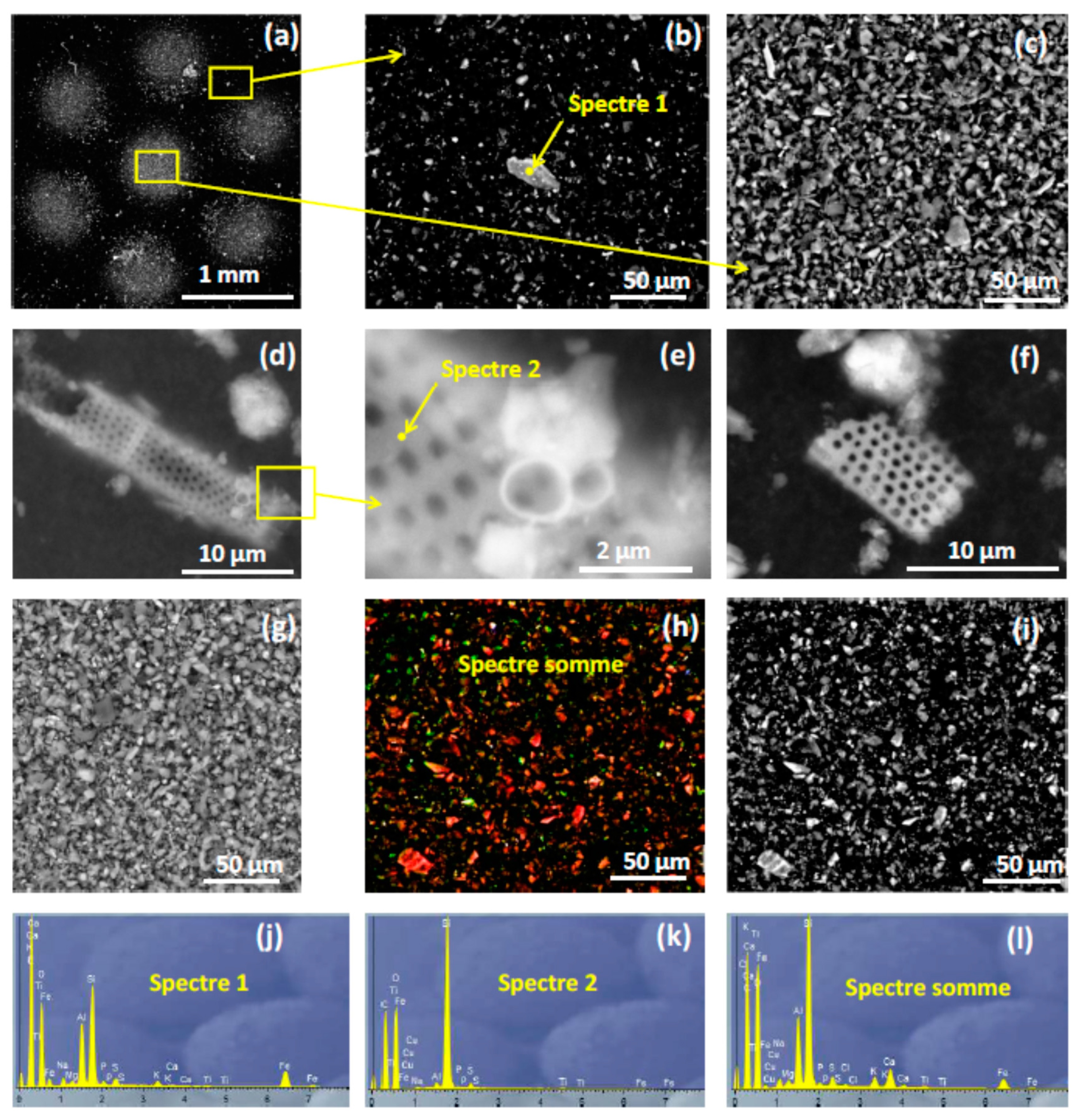
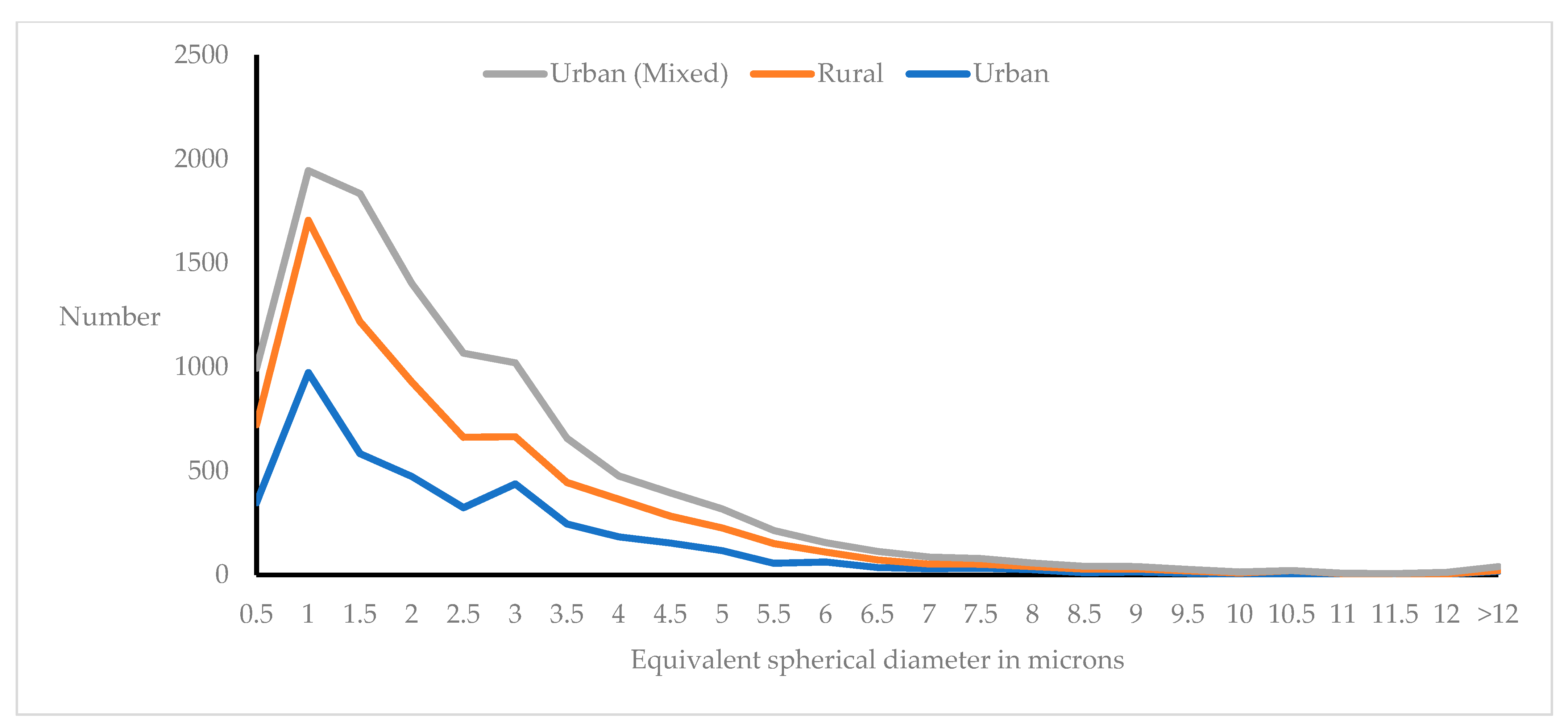
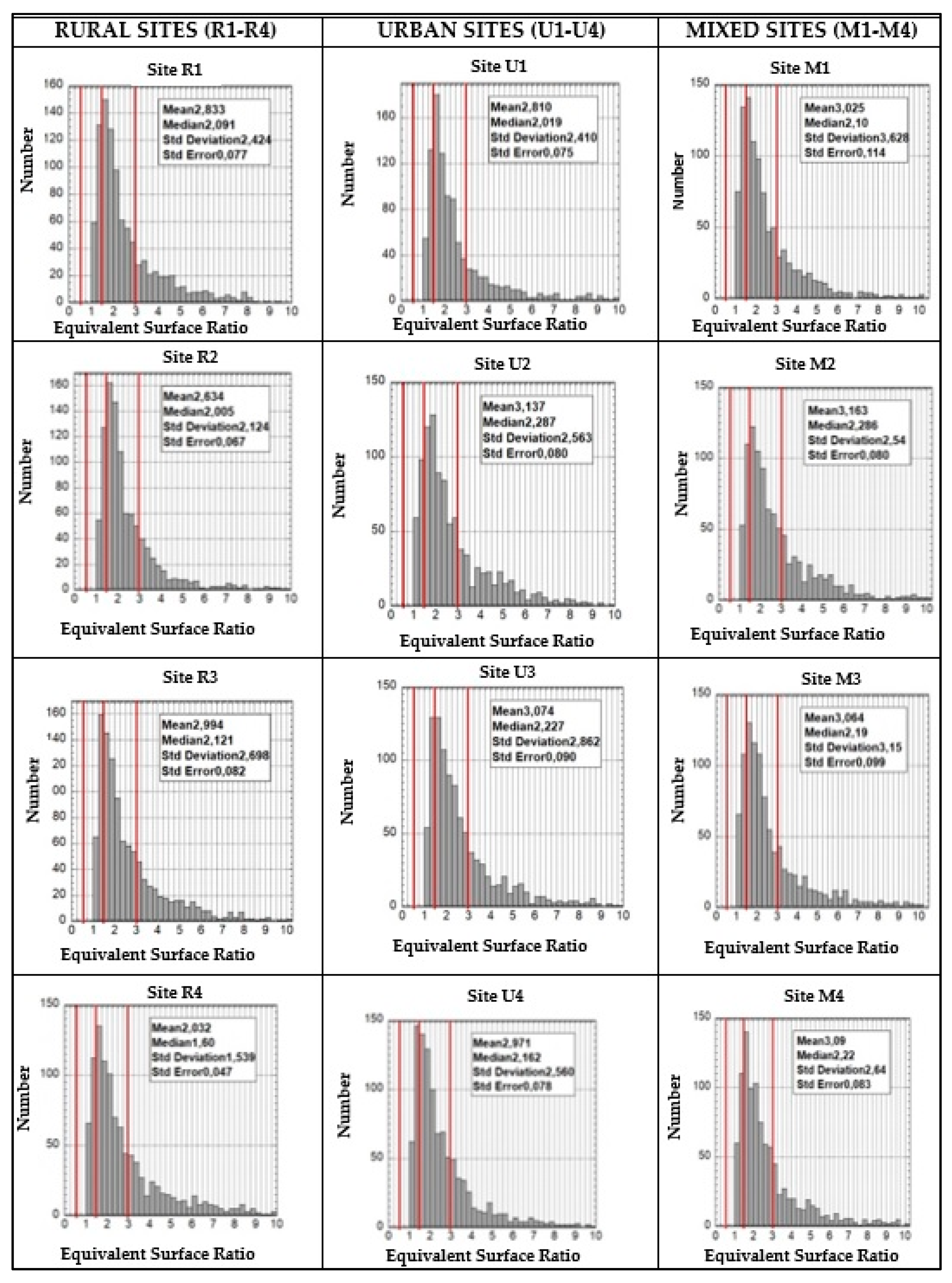
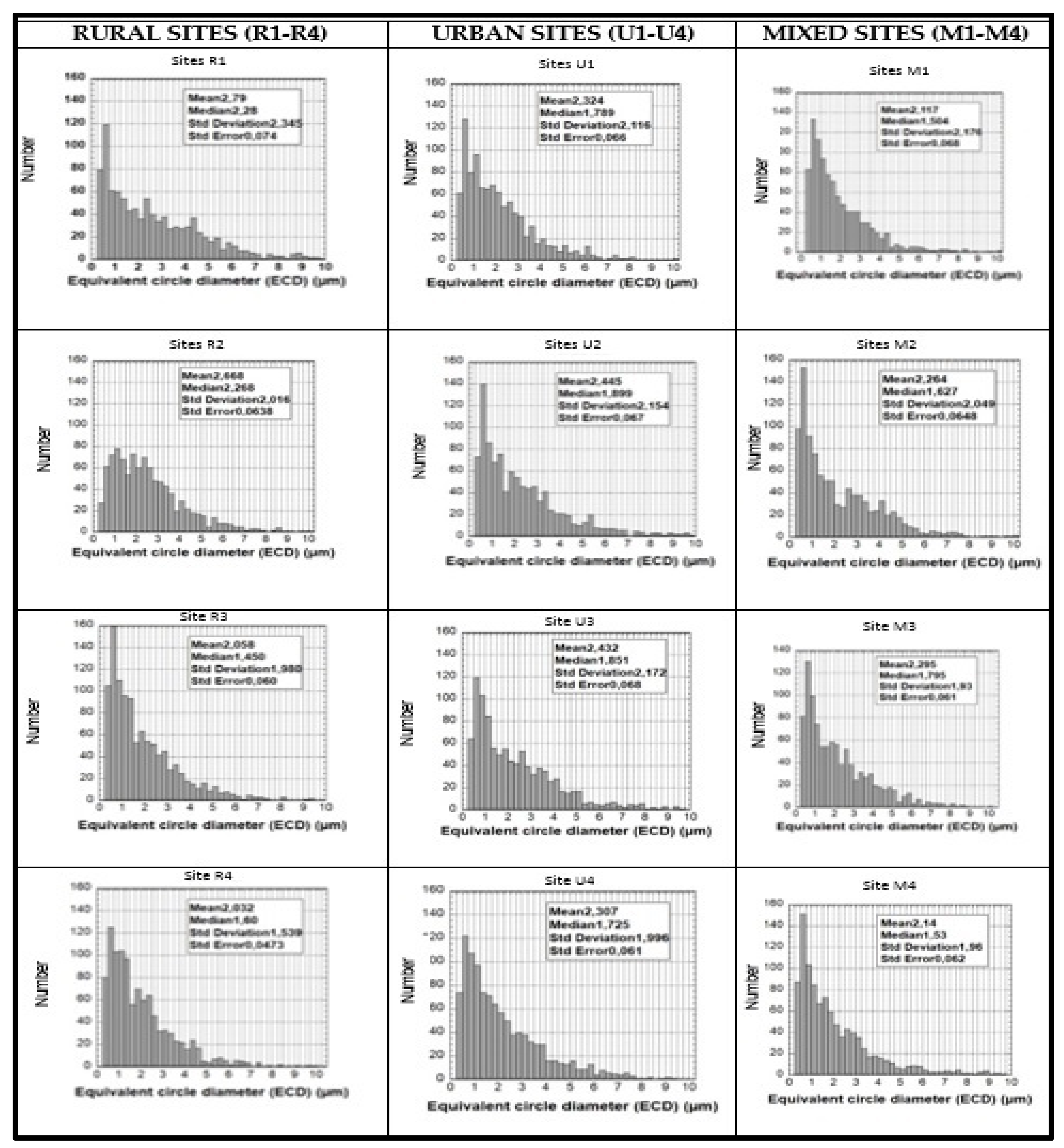
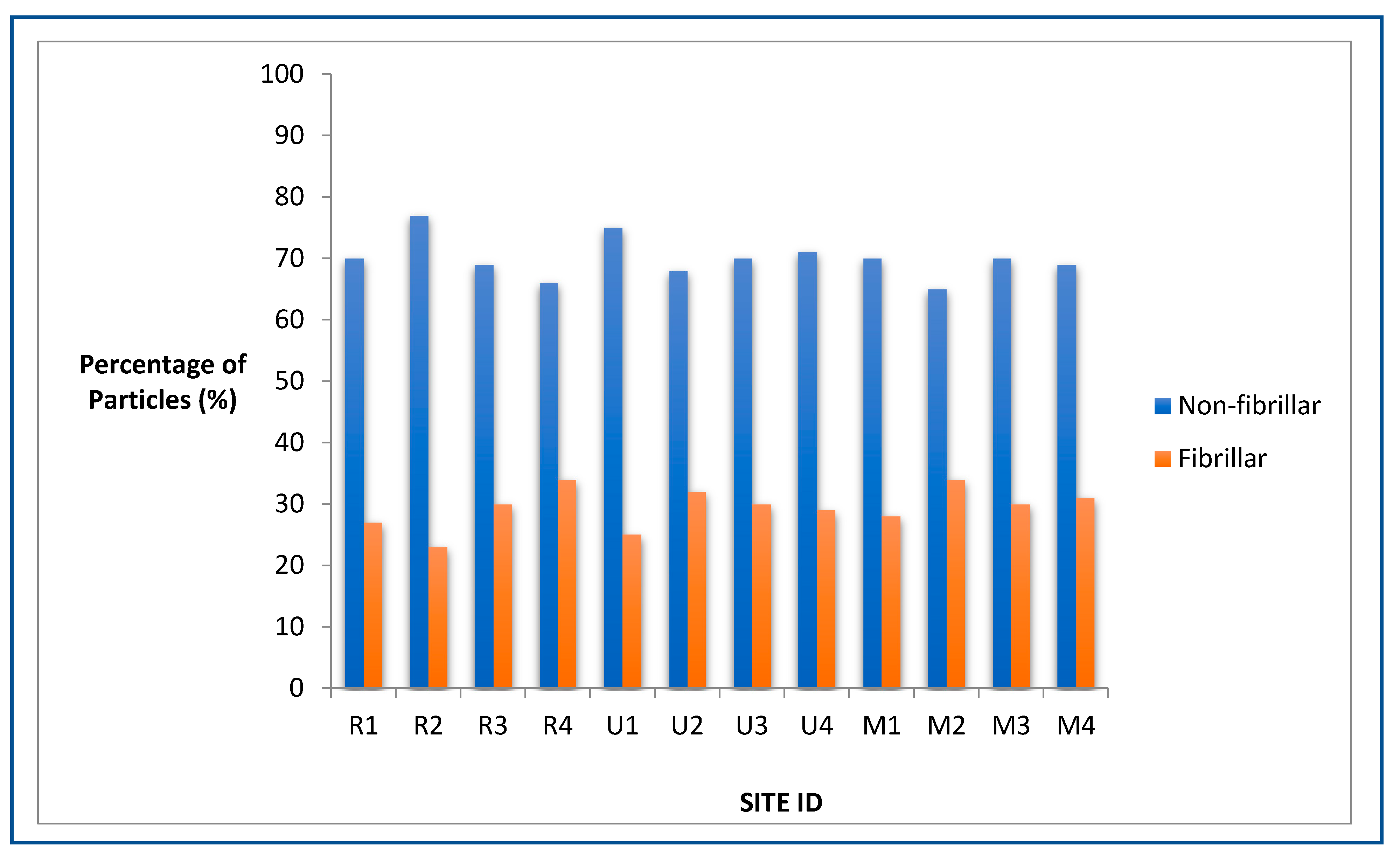
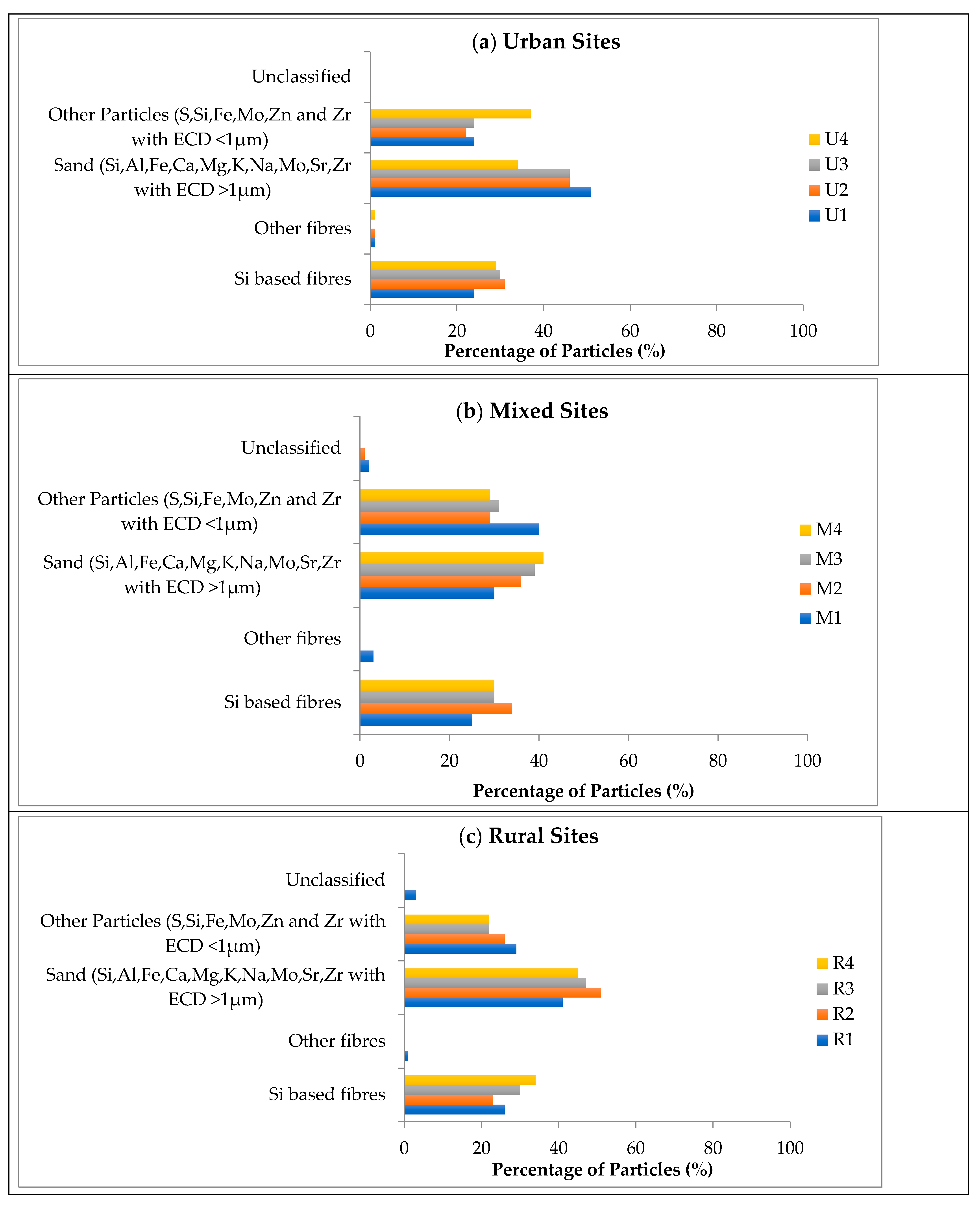
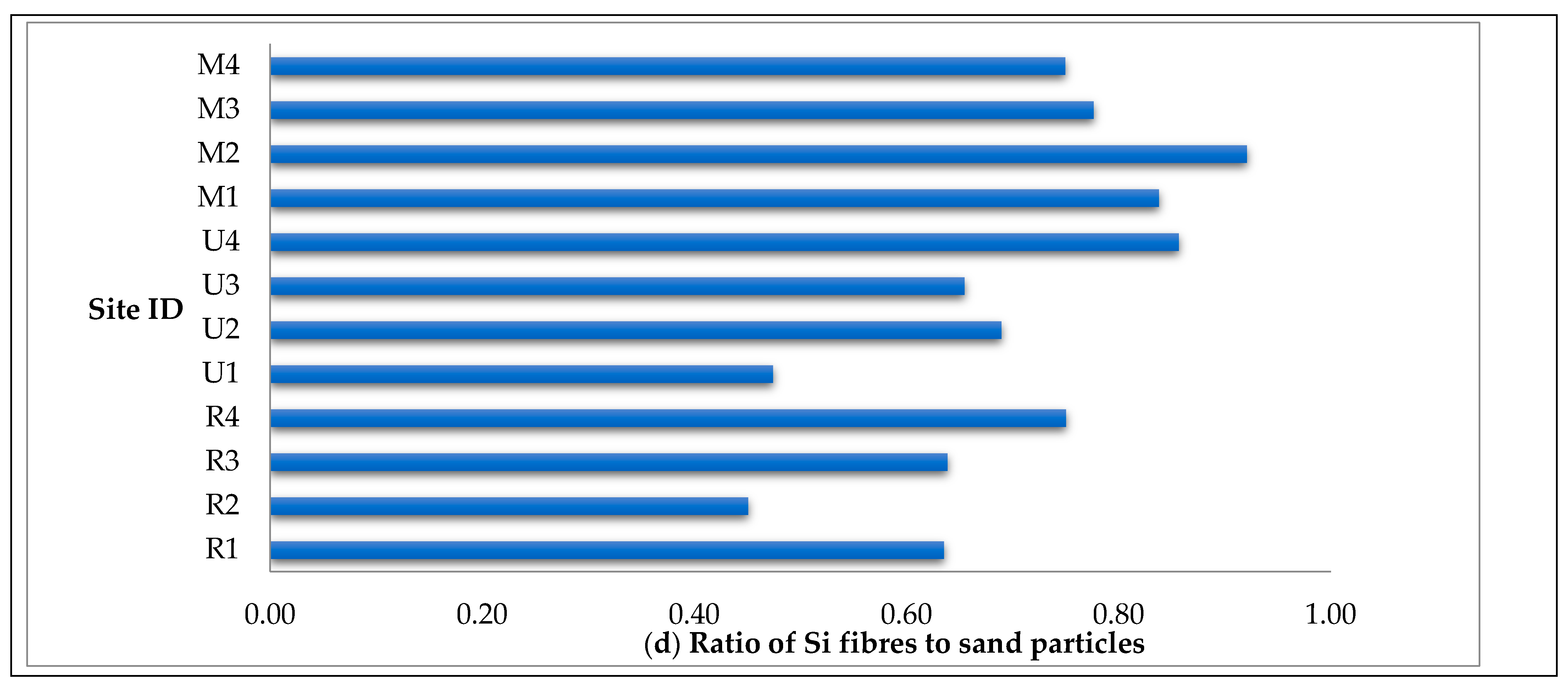
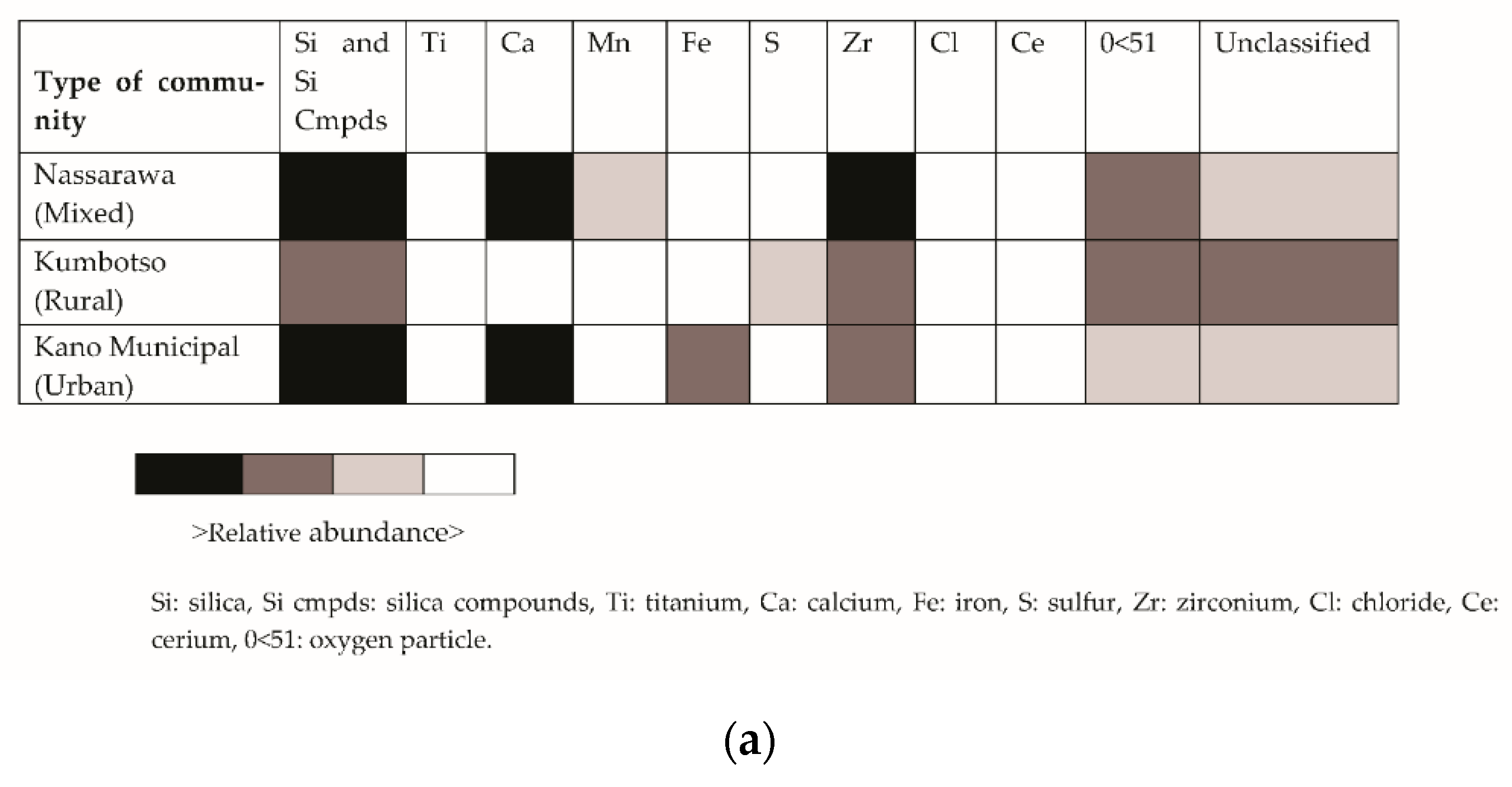
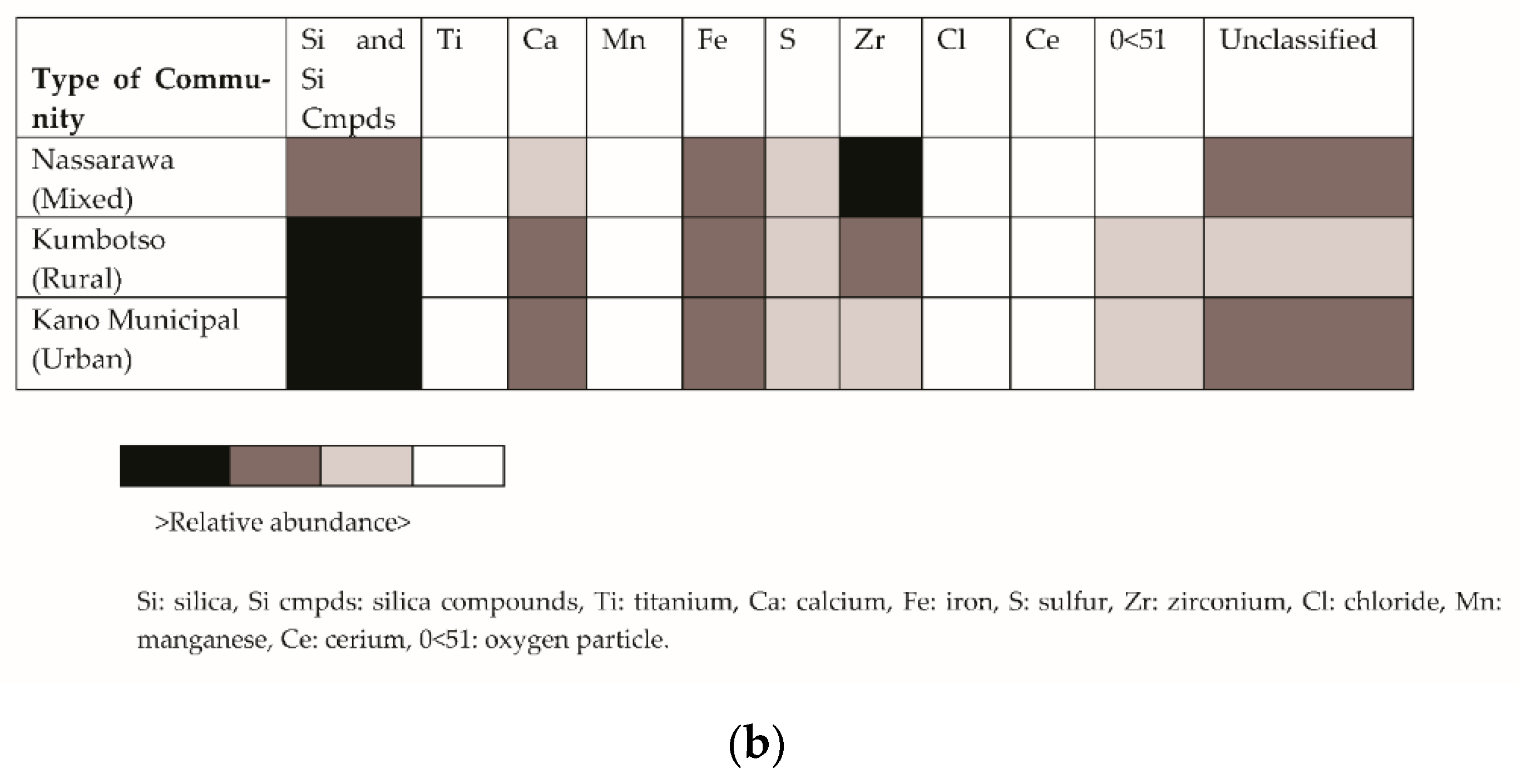
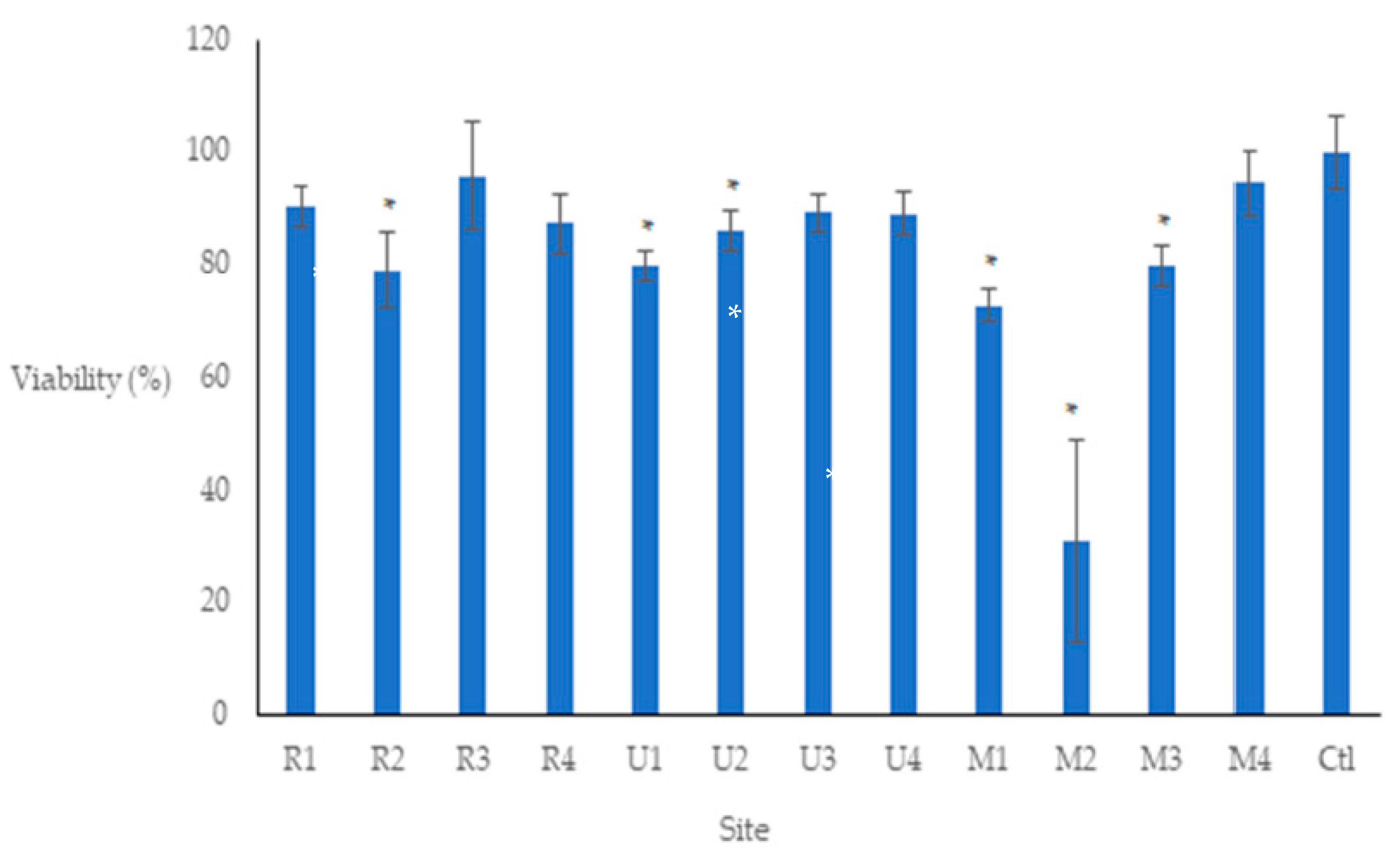
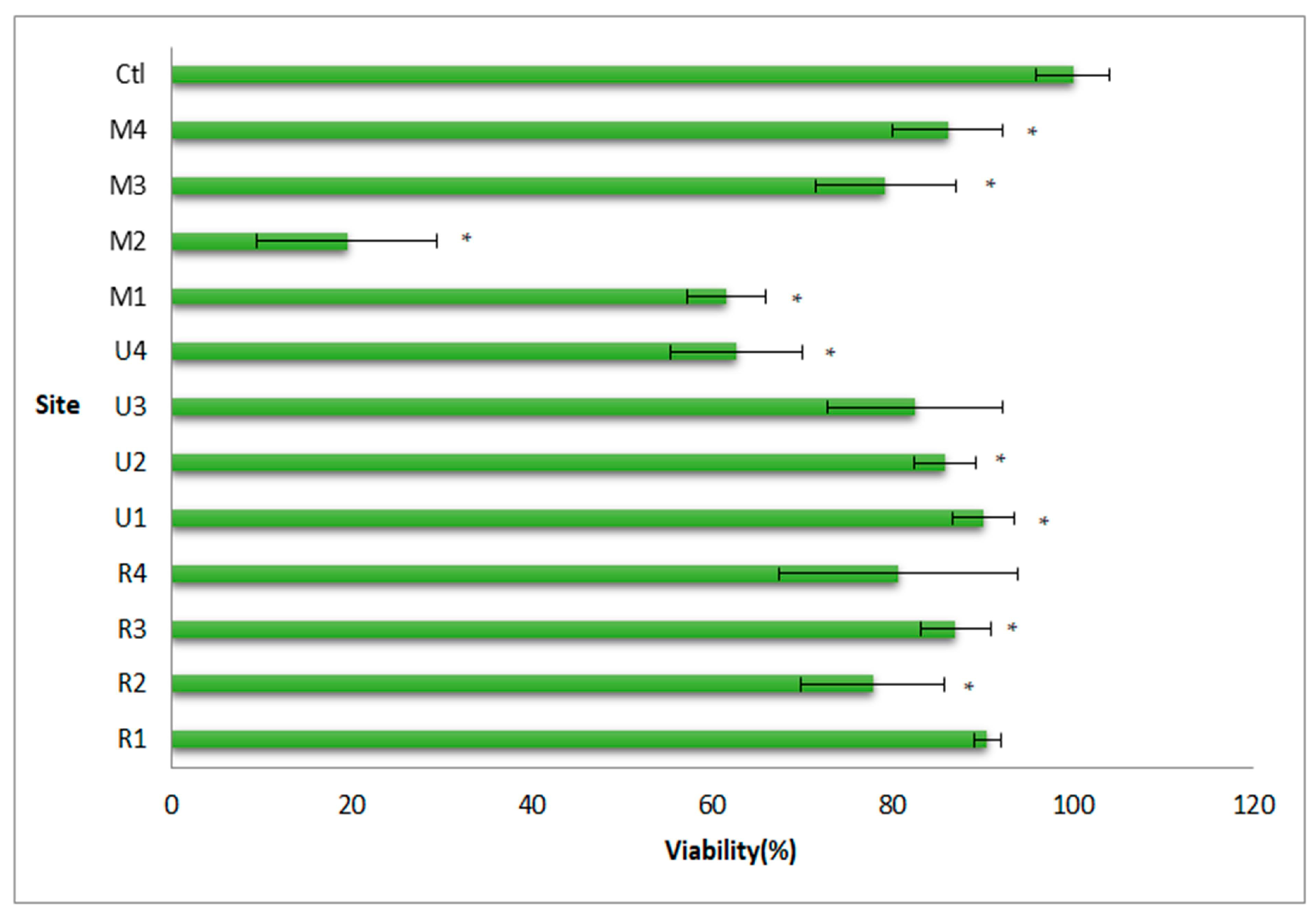
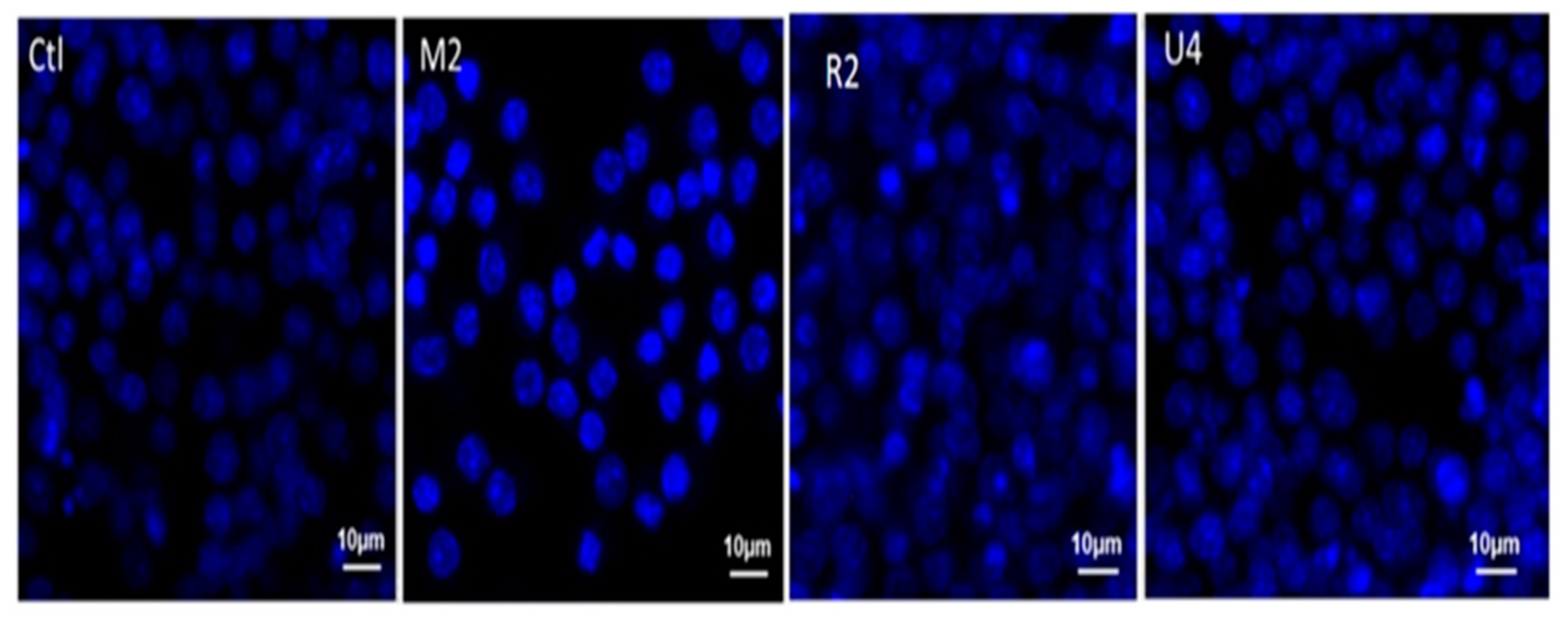
| Site ID | Name | Settlement Type/LGA | Traffic Density | Identified Pollution Sources |
|---|---|---|---|---|
| R1 | Masalacin Alhaji Abba Road | Rural Kumbotso | High | Traffic, grain thrashing, harmattan dust, open burning |
| R2 | Coca-cola Road | Low | Bottling plant, traffic, dust | |
| R3 | Turaki Memorial school Highway | Low | Traffic, harmattan dust, open burning | |
| R4 | Kumbotso village near highway | High | Traffic, open burning, agriculture | |
| M1 | Central Mosque area | Urban-Mixed Nassarawa | High | Traffic, local food industries, dust |
| M2 | Yankaba Car Park (Tashan Yankaba) | High | Traffic, automobile workshops, commercial car park, open burning, factories, dust | |
| M3 | Hadeija Road | Low | Traffic, open burning, harmattan dust | |
| M4 | Amau Yakubu street, GRA | Low | Traffic, open burning, dust | |
| U1 | Municipal Clinic Road | Urban Kano Municipal | Low | Traffic, harmattan dust |
| U2 | Kofar Mata Area | High | Traffic, harmattan dust | |
| U3 | Near British Council | High | Traffic, harmattan dust | |
| U4 | Layin Dantata Koki | Low | Traffic, harmattan dust |
| S/N | LGA/Site Number | Settlement Type | Distance to Households Mean ± SD (meTers) |
|---|---|---|---|
| 1 | Kano Municipal | ||
| Site: U1-U4 | Urban | 37.2 ± 27.0 | |
| 2 | Nassarawa | ||
| Site: M1-M4 | Mixed | 34.1 ± 21.7 | |
| 3 | Kumbotso | ||
| Site: R1-R4 | Rural | 36.8 ± 22.7 |
Publisher’s Note: MDPI stays neutral with regard to jurisdictional claims in published maps and institutional affiliations. |
© 2022 by the authors. Licensee MDPI, Basel, Switzerland. This article is an open access article distributed under the terms and conditions of the Creative Commons Attribution (CC BY) license (https://creativecommons.org/licenses/by/4.0/).
Share and Cite
Sadiq, A.A.; Khardi, S.; Lazar, A.-N.; Bello, I.W.; Salam, S.P.; Faruk, A.; Alao, M.A.; Catinon, M.; Vincent, M.; Trunfio-Sfarghiu, A.-M. A Characterization and Cell Toxicity Assessment of Particulate Pollutants from Road Traffic Sites in Kano State, Nigeria. Atmosphere 2022, 13, 80. https://doi.org/10.3390/atmos13010080
Sadiq AA, Khardi S, Lazar A-N, Bello IW, Salam SP, Faruk A, Alao MA, Catinon M, Vincent M, Trunfio-Sfarghiu A-M. A Characterization and Cell Toxicity Assessment of Particulate Pollutants from Road Traffic Sites in Kano State, Nigeria. Atmosphere. 2022; 13(1):80. https://doi.org/10.3390/atmos13010080
Chicago/Turabian StyleSadiq, Aishatu Abubakar, Salah Khardi, Adina-Nicoleta Lazar, Imam Wada Bello, Samson Polycarp Salam, Aisha Faruk, Mitchell A. Alao, Mickaël Catinon, Michel Vincent, and Ana-Maria Trunfio-Sfarghiu. 2022. "A Characterization and Cell Toxicity Assessment of Particulate Pollutants from Road Traffic Sites in Kano State, Nigeria" Atmosphere 13, no. 1: 80. https://doi.org/10.3390/atmos13010080
APA StyleSadiq, A. A., Khardi, S., Lazar, A.-N., Bello, I. W., Salam, S. P., Faruk, A., Alao, M. A., Catinon, M., Vincent, M., & Trunfio-Sfarghiu, A.-M. (2022). A Characterization and Cell Toxicity Assessment of Particulate Pollutants from Road Traffic Sites in Kano State, Nigeria. Atmosphere, 13(1), 80. https://doi.org/10.3390/atmos13010080







